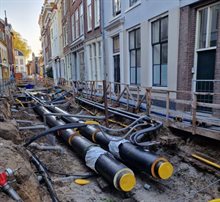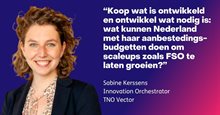Collective heat systems play a key role in the energy transition, because the more Dutch households stop using gas, the better. Meanwhile, things are already happening in that area. The National Growth Fund, for instance, has allocated 200 million euros to take 26,000 homes and buildings and more than 800 hectares of greenhouse horticulture off gas and connect them to collective heat systems. And all this in the most sustainable way possible.
Huge challenge
As Elsman points out, the slow pace is still a big problem. ‘It does, of course, help that thanks to the contribution from the National Growth Fund, 12 collective heat projects can now be implemented and there’s also money for the further development of 6 innovations that will contribute to the faster and sustainable creation of heat systems. But if we really want to achieve the desired acceleration, we need more funding. Much more. It’s very good, then, that a substantial amount of money has also been set aside for a learning and development programme, in which TNO is working with Deltares, Saxion University of Applied Sciences, and Energy Together (Energie Samen). Our main challenge is to gain an understanding of everything that helps build collective heat systems faster and more cheaply. Because to achieve the climate goals, we must create them much faster: not in 5 to 7 years, but preferably within 1 year. And yes, that’s a huge challenge.’
New heat legislation in the making
Technologically, much is already possible. That makes a difference. Moreover, the Dutch government has been working for some time on new heat legislation, which is likely to be introduced in 2025. The law is intended to ensure that public parties are given a much bigger role in developing, building, and managing collective heat systems.
Elsman expects this law to have a big impact. ‘Because public parties pursue a shared public purpose, sharing knowledge between them will soon be somewhat less sensitive. And that’s good news, because better knowledge sharing may ensure that collective heat systems can be scaled up faster.’
‘If all goes well, the new Collective Heat Act (Wet collectieve warmte) will make the market a lot more transparent, which will hopefully also make it easier to use well-founded information to convince private homeowners to opt for connecting to the heat grid.’ - Rinus Elsman, Strategy and Policy consultant at TNO Vector
Watching out for ‘gaps’ in the neighbourhood
Getting private homeowners on board is a key concern. This is because, to get the most out of a heat grid, it’s important to ensure that virtually all homes and buildings in a neighbourhood are connected to it. But up to now, this appears not to be so simple in practice. Because what if several private homeowners decide to heat their homes by other means, such as a heat pump?
‘It’s fine in itself to bet on several horses during the energy transition,’ says Elsman. ‘And heat pumps of course also play an important role in getting homes and buildings off natural gas. But opting for a heat pump can cause too many ‘gaps’ in a neighbourhood where a heat grid is being established, which immediately makes the business case for a heat grid look a lot worse.’
Learning by doing and doing while learning
And the list of challenges is much longer. Discussions to identify the learning needs among the 12 ongoing heat projects have made it clear that stakeholders are keen to delve more deeply into:
- The integrated area approach
- Forms of collaboration, organisational models, and ownership relationships
- Decision-making, licensing, and accompanying policies
- Crowded subsurface and surface
- Risk management
- Participation including residents and owners’ associations
- Bottlenecks in careful implementation
‘Everything we learn and develop during the 12 heat projects forms a great basis for the collective heat systems that will be put into operation in the future. That’s why we talk about “kick-start projects”,’ Elsman explains. ‘Because, by developing standards based on the experience gained, for example, we can create the impetus to kick start the implementation of new heat projects.’
Faster and easier upscaling
In addition to the kick-start projects, specific innovations that help accelerate the development of sustainable collective heat grids are also being worked on within New Heat Now. ‘Through targeted workshops, we’re trying to focus more strongly on these innovations. And of course, we also encourage good knowledge sharing, because that’s a key prerequisite for achieving faster and easier upscaling of these innovations.’
Communities of Practice
The fact that problems currently arise regularly during kick-start projects, with everyone aware of the need to devise an appropriate solution quickly, is exactly what Elsman says is needed to achieve the desired acceleration.
‘Real-life practice is erratic. This means that you can’t really figure out in advance what problems you’ll face in practice. And with multiple projects underway, solutions to specific problems are constantly being devised. In this process, it’s important to make that knowledge available to everyone involved in the kick-start projects. This is currently happening through Communities of Practice. By connecting in the communities to the themes within the projects, we try to make the knowledge relevant to practical application. In the process, discussions between those involved provide the necessary deepening of that knowledge. It’s really great to see how quickly knowledge spreads in this way.’




